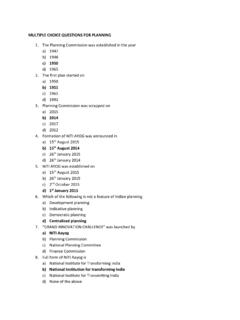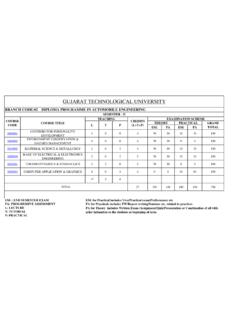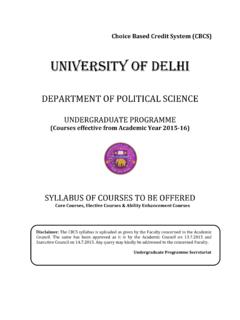Transcription of Multiple Choice Questions, M.B.B U, Semester III Pass
1 Multiple Choice Questions, U, Semester III Pass 1. Which of the following statement is inconsistent with Say s Law (a) The economy has flexible wages and prices. (b) The economy s level of investment solely depends on the level of income. The economy will produce at full employment level of output. (d) The economy has an environment of laissez faire . 2. Marginal Propensity to Consume is (a) Increase in consumption due to one unit increase in income. (b) Total consumption divided by total income. Both (a) and (b). (d) Neither (a) nor (b). 3. In explaining the level of unemployment, Keynes emphasized,- (a) Changes in technology. (b) Aggregate demand. Inflationary expectations. (d) Lending by financial institutions. 4. Assume that the consumption function is of the form, C= 50+.8Y. If income is Rs 1000/- then consumption is,- (a) Rs 50/- 9b) Rs 1050/- Rs 50/- (d) Rs 850/-. 5. In the simple Keynesian model consumption is a function of, (a) Rate of interest. (b) Level of income.
2 Price level. (d) None of the above. 6. In the simple Keynesian model investment is (a) Fixed. (b) A function of level of income. Either fixed or a function of level of income. (d) None of the above. 7. Which of the following statement is incorrect,- In simple Keynesian model,- (a) MPC+MPS=1 (b) APC+ APS=1 Both (a) and (b) (d) Neither (a) nor (b). 8. In simple Keynesian model, stability of equilibrium exists, if (a) APC is less than one. (b) APS is less than one. MPC is less than one. (d) None of the above. 9. Keynesian analysis is (a) A short run analysis. (b) Long run analysis. Both short and long run analysis. (d) Neither short nor long run analysis. 10. The average propensity to consume is measured by (a) C/Y (b) C=Y Y/C (d) C+Y 11. An increase in marginal propensity to consume will (a) Lead to the consumption function becoming steeper. (b) Shift the consumption function upwards. Shift the consumption function downwards. (d) Shift the savings function upwards. 12.
3 If the Keynesian consumption function is, C=10+.8Y, if income is Rs 1000/- what is total consumption. (a) Rs .8/- (b) Rs 800/- Rs 810/- (d) Rs .81/- 13. An increase in consumption at any given level of income will lead to (a) Higher aggregate demand. (b) An increase in exports. A fall in taxation revenue. (d) A decrease in import spending. 14. Lower interest rates are likely to (a) Decrease consumption. (b) Increase cost of borrowing. Encourage saving. (d) Increase borrowing and spending. 15. The marginal propensity to consume is equal to (a) Total spending/Total consumption (b) Total consumption/ Total income. Change in consumption/ Change in income (d) Change in consumption/ Change in savings. 16. An increase in investment is caused by (a) Lower interest rates (b) Expectations of lower national income A decrease in the marginal propensity to consume (d) An increase in withdrawals 17. An increase in interest rates (a) is likely to reduce savings (b) is likely to reduce external value of currency Leads to a shift in the MEC schedule (d) Leads to a movement along MEC schedule.
4 18. Which of the following are not characteristics of Keynesian consumption function? (a) The main influence on consumption in the short run is current disposable income (b) The marginal propensity to consume is less than one The average propensity to consume decreases as income increases (d) The average propensity to consume increases as income increases. 19 .An increases in investment is most likely to be caused by (a) Lower interest rates (b) Expectations of lower national incomes A decrease in the marginal propensity to consume (d) An increase in withdrawals. 20 .A profit maximizing firm will invest up to the level of investment where (a) The cost of borrowing equals marginal efficiency of capital (b) The cost of borrowing is greater than marginal efficiency of capital The cost of borrowing is less than marginal efficiency of capital (d) The cost of borrowing is equal to marginal propensity to consume. 21. Investment is (a) An injection that increases aggregate demand (b) An withdrawal that increases aggregate demand An injection that decreases aggregate demand (d) An withdrawal that decreases aggregate demand 22.
5 If an increase in investment leads to a bigger increase in national income (a) Accelerator (b) Aggregate demand Monetarism (d) Multiplier 23. The difference between gross investment and net investment is (a) Depreciation (b) Acceleration Deceleration (d) Capital investment 24 .Induced investment depends on (a) Price level and rate of interest (b) Level of income and rate of interest Level of employment and wage rate (d) Price level and wage rate. 25. What posses general acceptability? (a) Bill of exchange (b) Bond Money (d) Bank draft 26. Which type of bank deals with short term credit? (a) Agricultural bank (b) Industrial bank Commercial bank (d) None of these 27. Which of the following is not the function of commercial banks? (a) Issue of paper notes. (b) Credit control. Acceptance of deposits (d) Advancing loans. 28. Which bank is called lender of the last resort? (a) Agricultural bank (b) Industrial bank Commercial bank (d) Central bank 29. Which bank enjoys monopoly power of note issue?
6 (a) NABARD (b) Agricultural bank Industrial bank (d) Central bank. 30. Which bank deals with income and expenditure of the Government? (a) Commercial bank (b) Agricultural bank Industrial bank (d) Central bank. 31. Demand pull inflation may be caused by (a) An increase in cost (b) A decrease in interest rate A reduction in government spending (d) An outward shift of aggregate supply. 32. Inflation (a) Always reduces cost of living (b) Always reduces standard of living Reduces price of products (d) Reduces purchasing power of money increase in aggregate demand is more likely to lead to demand pull inflation (a) If aggregate supply is completely elastic (b) If aggregate supply is completely inelastic If aggregate supply is unitary elastic (d) If aggregate supply is moderately elastic 34. Which of the following phases describes the phase of business cycle that occurs after a trough and before a peak (a) Lag (b) Consolidation Expansion (d) Contraction 35. A period of expansion and contraction measured by real GDP is called (a) Business cycle (b) Expansion Recession (d) Contraction 36.
7 Which of the following is an example of fiscal policy (a) Change in interest rate (b) Change in tax rate Controlling money supply (d) Manipulating bank rate 37. Which of the following is not a component of GDP? (a) Government spending (b) Investment Interest (d) Net exports 38. In a boom (a) Unemployment is likely to fall. (b) Prices are likely to fall Demand is likely to fall (d) Imports are likely to fall to Acceleration principle investment depends on change in the level of------ (a) rate of interest. (b) level of income. price (d) saving. 40. Keynesian theory of investment is known as ----- (a) Marginal Efficiency of Capital Theory. (b) Marginal Efficiency of Investment Theory. Optimum Stock of Capital Theory. (d) Actual Stock of Capital Theory. Semester V Pass Indian Economy GE Paper-I 1 The largest portion of national income comes from (a) Public Sector (b) Private Sector Local Sector (d) None of them. 2. Savings represent (a) An injection to the circular flow of income (b) A withdrawal into the circular flow Both an injection and a withdrawal (d) None of the above.
8 3. What base year is used to calculate per capita income in India? (a) 2004-05 (b) 2011-12 2001-02 (d) 2014-15 4. Which state in India now has the highest per capita income? (a) Goa (b) Delhi Punjab (d) Kerala. 5. How much the primary sector contributes to India s national income? (a) 20 percent (b) 53 percent 14 percent (d) 24 percent. 6. Which sector contributes largest to India s national income? (a) Agricultural sector (b) Manufacturing sector Service sector (d) Small scale industry. 7. The contribution of agricultural sector is decreasing in India s economy then what conclusion can be drawn? (a) India is growing towards a developed economy. (b) India is growing towards a developing economy. India is growing towards a less developed economy. (d) None of the above. 8. Which is not added in the calculation of national income in India? (a) The value of goods and services. (b) The sold value of old fridge. Services rendered by the housewives (d) Both (b) and (c) 9. In India agricultural income is calculated by (a) Income method (b) Output method Expenditure method (d) None of them.
9 10. Per capita income is calculated by dividing total national income by (a) Total population (b) Total savings Total depreciation (d) Total investment. 11. Which of the following statements defines density of population? (a) Number of persons living in per unit area. (b) Number of persons living in a country Change in the number of inhabitants of a country during a specific period of time. (d) Absolute numbers added every year. 12. Which of the following states/union territories has the lowest sex ratio? (a) Kerala (b) Goa. Delhi (d) Haryana. 13. A person aged 7years who can read, write and with understanding in any language is treated as (a) Illiterate (b) Literate Migrant (d) Immigrant. 14. Who conducts periodical sample survery for estimating poverty line in India? (a) National Survery Organisation (b) National Sample Survery Organisation (c) National Sample Survey Organisation (d) None of the above. how many days NREGA provides employment? (a) 70 days (b) 80 days 90 days (d) 100 days 16.
10 Which among the following method is used to calculate poverty in India? (a) Investment Method. (b) Capital Method. Savings Method. (d) Income Method. 17. What is the average calorie intake of rural India for measuring poverty line? (a) 2400 calories per person per day. (b) 2800 calories per person per day. 2100 calories per person per day. (d) None of these. 18. The calorie requirement is higher in the rural areas because (a) They do not enjoy as much as people in the urban areas (b) Food items are expensive (c) They are engaged in mental work (d) People are engaged in physical labour 19. Which of the following is an indicator of poverty in India? (a) Income level (b) Illiteracy level (c) Employment level (d) All of these. 20. Which one of the following Economic groups is vulnerable to poverty? (a) Scheduled Caste (b) Scheduled Tribes (c) Rural Agricultural Household (d) All of the above. 21. From___Five Year Plan definite measures to reduce unemployment were undertaken. (a) First (b) Third Fifth (d) Seventh 22.




